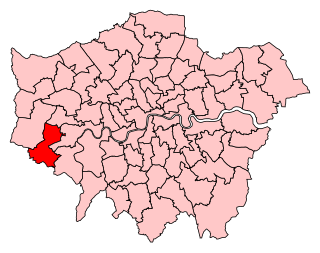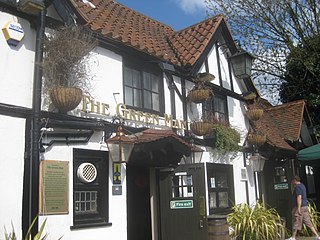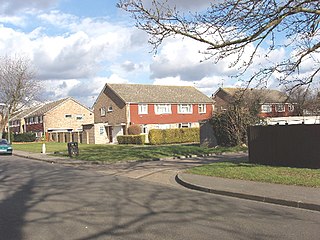Related Research Articles

Heathrow Airport, originally called London Airport until 1966 and now known as London Heathrow, is a major international airport in London, England. With Gatwick, City, Luton, Stansted and Southend, it is the largest of the six international airports serving serving Greater London. The airport facility is owned and operated by Heathrow Airport Holdings. In 2021, it was the seventh-busiest airport in the world by international passenger traffic and eighth-busiest in Europe by total passenger traffic.

Hounslow is a large suburban district of West London, 10.7 miles (17.2 km) west-southwest of Charing Cross. It is the administrative centre of the London Borough of Hounslow, and is identified in the London Plan as one of the 12 metropolitan centres in Greater London.

The London Borough of Hounslow is a London borough in West London, England, forming part of Outer London. It was created in 1965 when three smaller borough councils amalgamated under the London Government Act 1963. It is governed by Hounslow London Borough Council.

Sipson is a village in the London Borough of Hillingdon, the westernmost borough of Greater London, England. It is 14.3 miles (23 km) west of Charing Cross and near the north perimeter of London Heathrow Airport.

Gatwick Airport, also known as London Gatwick, is a major international airport near Crawley, West Sussex, England, 29.5 miles (47.5 km) south of Central London. In 2021, Gatwick was the third-busiest airport by total passenger traffic in the UK, after Heathrow and Stanstead Airports, and was the 36th-busiest in Europe by total passenger traffic. It covers a total area of 674 hectares.

London City Airport is a regional airport in London, England. It is located in the Royal Docks in the London Borough of Newham, approximately 6 miles (9.7 km) east of the City of London and 3 miles (4.8 km) east of Canary Wharf. These are the twin centres of London's financial industry, which is a major user of the airport. The airport was developed by the engineering company Mowlem in 1986–87. In 2016 it was bought by a Canadian-led consortium of Alberta Investment Management Corporation (AIMCo), OMERS, the Ontario Teachers' Pension Plan and Wren House Infrastructure Management of the Kuwait Investment Authority.

Manchester Airport is an international airport at Ringway, Manchester, England, 7.5 nautical miles south-west of Manchester city centre. In 2019, it was the third busiest airport in the United Kingdom in terms of passenger numbers and the busiest of those not serving London. The airport comprises three passenger terminals and a cargo terminal, and is the only airport in the UK other than Heathrow Airport to operate two runways over 3,280 yd (2,999 m) in length. Manchester Airport covers an area of 560 hectares and has flights to 199 destinations, placing the airport thirteenth globally for total destinations served.

Longford is a suburban village in the London borough of Hillingdon, England. It is immediately northwest of London Heathrow Airport, which is in the same borough. It is the westernmost settlement in Greater London, close to the borders of Berkshire and Surrey.

Feltham and Heston is a constituency created in 1974 represented in the House of Commons of the UK Parliament. Its MP since 2011 is Seema Malhotra of the Labour Co-operative Party, which is in political union with the Labour Party.

The River Crane, a tributary of the River Thames, runs 8.5 miles (13.6 km) in West London, England. It forms the lower course of Yeading Brook. It adjoins or passes through three London boroughs: Hillingdon, Hounslow and Richmond upon Thames, in the historic county of Middlesex. The drainage basin is heavily urbanised but many of the Hayes to Whitton flood-meadows have been conserved, forming a narrow, green vale, opening out to what remains of Hounslow Heath in the centre – a near-continuous belt of semi-natural habitat.

Hatton including Hatton Cross is a small settlement and locality in the historic County of Middlesex and the London boroughs of Hillingdon and Hounslow, on the south-eastern edge of London Heathrow Airport and straddling the A30 road.

Cranford is a suburban area in the London Borough of Hounslow, England. It is located 12.5 miles (20 km) west of Charing Cross and immediately east of Heathrow Airport, from which it is separated by the River Crane. A village till the mid-20th century, Cranford was developed with the building of major roads in its area.

London Buses route 111 is a Transport for London contracted bus route in London, England, running between Heathrow Airport and Kingston. It is operated by Abellio London.

Heathrow Airtrack was a proposed railway link in the United Kingdom which would link Heathrow Airport in west London to London Waterloo railway station in Central London.

The environmental effects of aviation in the United Kingdom are increasing due to the increasing demand for air travel in the country. In the past 25 years the UK air transport industry has seen sustained growth, and the demand for passenger air travel in particular is forecast to increase more than twofold, to 465 million passengers, by 2030. Two airports; London Heathrow and London Gatwick, are amongst the top ten busiest airports in the world for international passenger traffic. Whilst more than half of all passengers travelling by air in the UK currently travel via the five London area airports, regional airports have experienced the most growth in recent years, due to the success of 'no-frills' airlines over the last decade.
The expansion of Heathrow Airport is a series of proposals to add to the runways at London's busiest airport beyond its two long runways which are intensively used to serve four terminals and a large cargo operation. The plans are those presented by Heathrow Airport Holdings and an independent proposal by Heathrow Hub with the main object of increasing capacity.
In its early years what is now Heathrow Airport was the Great West Aerodrome, sometimes known as Heathrow Aerodrome.
The metropolitan area of London, England, United Kingdom, is served by six international airports and several smaller airports. Together, they make the busiest airport system in the world by passenger numbers and the second-busiest by aircraft movements. In 2018, the six airports handled a total of 177,054,819 passengers. The London airports handle over 60% of all the UK's air traffic. The airports serve a total of 14 domestic destinations and 396 international destinations.
The expansion of Gatwick Airport has involved several proposals aimed at increasing airport capacity in south east England and relieving congestion at the main hub airport Heathrow.

John Stewart is a British environmental campaigner who specializes in transport issues and noise pollution. In the 1980s and 1990s, he helped coordinate a national network of community groups that successfully campaigned against the British government's then-£23-billion road-building programme. Later, Stewart led the successful campaign against a third runway at Heathrow Airport. He has several times been recognized as one of Britain's most effective environmental campaigners.
References
- ↑ "Letter about Cranford Agreement in response to a Freedom of Information Request" (PDF). Department for Transport. 2 August 2005. Archived from the original (PDF) on 11 May 2009. Retrieved 13 May 2012.
- ↑ "Heathrow runway plans scrapped by new government". BBC. 12 May 2010. Retrieved 13 May 2012.
- ↑ "Heathrow Operations". Department for Transport. 7 September 2010. Retrieved 3 March 2017.
- ↑ "End of the Cranford Agreement - But It's a Missed Opportunity". windsorpeople.co.uk. 18 October 2010. Archived from the original on 5 May 2013. Retrieved 3 March 2017.
- ↑ "Review of Heathrow's Noise Mitigation Schemes A Heathrow Airport Consultation" (PDF). London Borough of Hounslow. 1 August 2011. Archived from the original (PDF) on 2 August 2014. Retrieved 13 May 2012.
- ↑ "Cranford Agreement". heathrow.com. Retrieved 3 March 2017.